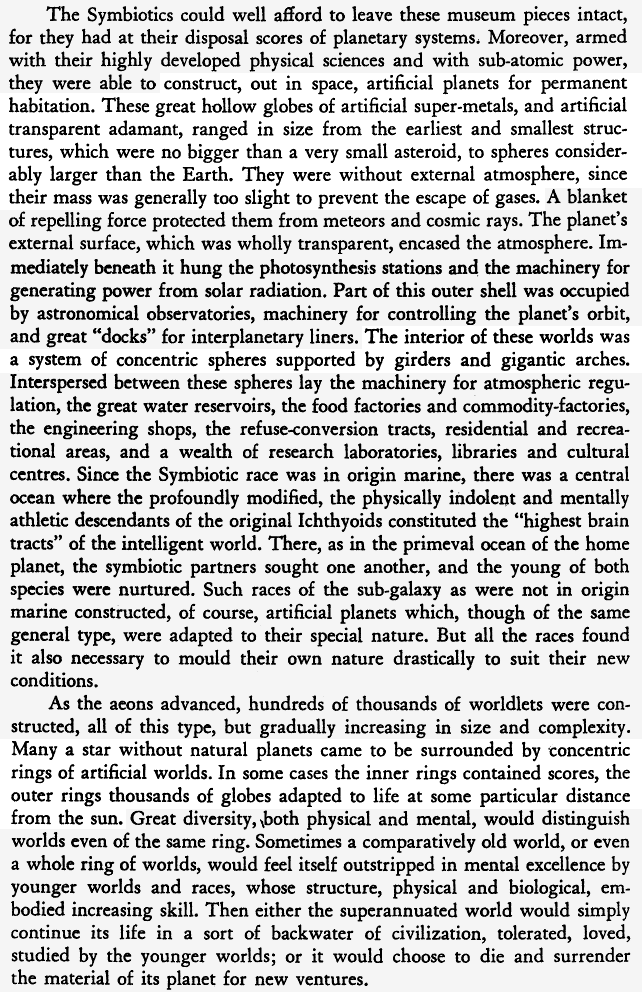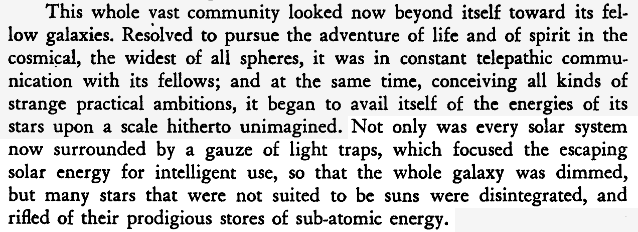|
Size: 1846
Comment:
|
Size: 1846
Comment:
|
| Deletions are marked like this. | Additions are marked like this. |
| Line 2: | Line 2: |
| = The Stapleton-Dyson Artificial Globe = | = The Stapledon-Dyson Artificial Globe = |
| Line 4: | Line 4: |
| In ''Disturbing the Universe'' (1979), Freeman Dyson credits Olaf Stapleton's 1937 ''Star Maker'' with the idea that is now called the Dyson Sphere. According to Wikipedia, Dr. Dyson wished the concept had not been named after him. | In ''Disturbing the Universe'' (1979), Freeman Dyson credits Olaf Stapledon's 1937 ''Star Maker'' with the idea that is now called the Dyson Sphere. According to Wikipedia, Dr. Dyson wished the concept had not been named after him. |
| Line 6: | Line 6: |
| OK, let's call it a "'''Stadyshell'''", which can be an abbreviation for "'''STA'''pleton '''DY'''son shell", or a "'''STA'''tite '''DY'''namic" shell. Stapleton gets more letters, though is biologically static, while Dyson gets two letters befitting his modesty and his biologically dynamic status. This site describes a dynamic statite shell, light pressure balancing gravity, with a tiny amount of dynamic control keeping it stable. Not much control is needed; at 50 AU (7.46e12 m), the Sun's gravitational force is 2.4 μm/s^2^ (1.327e20/7.46e12^2 m/s^2^) , and a 0.1% control error over one minute is a displacement error of 4 μm. | OK, let's call it a "'''Stadyshell'''", which can be an abbreviation for "'''STA'''pledon '''DY'''son shell", or a "'''STA'''tite '''DY'''namic" shell. Stapledon gets more letters, though is biologically static, while Dyson gets two letters befitting his modesty and his biologically dynamic status. This site describes a dynamic statite shell, light pressure balancing gravity, with a tiny amount of dynamic control keeping it stable. Not much control is needed; at 50 AU (7.46e12 m), the Sun's gravitational force is 2.4 μm/s^2^ (1.327e20/7.46e12^2 m/s^2^) , and a 0.1% control error over one minute is a displacement error of 4 μm. |
| Line 20: | Line 20: |
| Many are inspired by ''Star Maker''. I found it almost unreadable. It is quite imaginative and daring, and with more forbearance I could translate the 1937 ideas into modern form - "telepathy" to "brain interface", for example. So, I will do my best to credit Stapleton for his imagination, and Dr. Dyson for his rigor, but will read science and imagine/design technology instead. | Many are inspired by ''Star Maker''. I found it almost unreadable. It is quite imaginative and daring, and with more forbearance I could translate the 1937 ideas into modern form - "telepathy" to "brain interface", for example. So, I will do my best to credit Stapledon for his imagination, and Dr. Dyson for his rigor, but will read science and imagine/design technology instead. |
The Stapledon-Dyson Artificial Globe
In Disturbing the Universe (1979), Freeman Dyson credits Olaf Stapledon's 1937 Star Maker with the idea that is now called the Dyson Sphere. According to Wikipedia, Dr. Dyson wished the concept had not been named after him.
OK, let's call it a "Stadyshell", which can be an abbreviation for "STApledon DYson shell", or a "STAtite DYnamic" shell. Stapledon gets more letters, though is biologically static, while Dyson gets two letters befitting his modesty and his biologically dynamic status. This site describes a dynamic statite shell, light pressure balancing gravity, with a tiny amount of dynamic control keeping it stable. Not much control is needed; at 50 AU (7.46e12 m), the Sun's gravitational force is 2.4 μm/s2 (1.327e20/7.46e122 m/s2^) , and a 0.1% control error over one minute is a displacement error of 4 μm.
The relevant passages scanned from Starmaker (Dover, implying public domain, no copyright notice, correct me if I am wrong):
Chapter IX, The Community of Worlds, Section 4, Triumph In a Subgalaxy Paragraph 5:

Chapter X, A Vision of the Galaxy, 3rd to last paragraph:

The highlighted excerpt is quoted on page 211 of the first hardback edition of Disturbing the Universe.
Many are inspired by Star Maker. I found it almost unreadable. It is quite imaginative and daring, and with more forbearance I could translate the 1937 ideas into modern form - "telepathy" to "brain interface", for example. So, I will do my best to credit Stapledon for his imagination, and Dr. Dyson for his rigor, but will read science and imagine/design technology instead.
